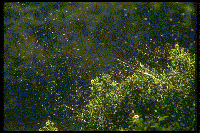Midges and Gnats
ENTFACT-632: Midges and Gnats | Download PDF
by Lee Townsend, Extension Entomologist
University of Kentucky College of Agriculture
Midges and gnats are common names for a large number of small, non-biting flies. Many species look like mosquitoes and may form annoying swarms or clouds in the air but they do not bite. The immature stages develop in water in pools, containers, ponds, clogged rain gutters, or in some cases, wet soil or seepage areas. Most feed on living or decaying plant matter and are an important part of aquatic food chains. Many species can survive in very stagnant or polluted water.

Mating Swarm of Midges
Large mating swarms of adults often appear about dusk and may occur for several days, especially after a prolonged wet period. Many gnats are attracted to light and may be a nuisance, landing on people or entering homes or businesses. These tiny flies do not feed. They only live long enough to mate, lay eggs, and die. Eggs are laid in masses in the water or on aquatic vegetation. The life cycle usually takes about 4 to 5 weeks. There may be several generations during the summer but these insects usually disappear with the onset of dry weather. Fortunately, problems are usually temporary and intermittent.
There are no good alternatives for control of the adults, other than some pressurized aerosol sprays containing pyrethrins. These are impractical for treating anything other than small areas. These products only kill insects that are directly hit by spray particles; there is no lasting or residual effect. More gnats will quickly enter the area after the spray has settled. The gnats rest on vegetation and in the grass during the day, so an application of a Cythion (malathion) or Sevin (carbaryl) spray may reduce numbers somewhat.
Long term control requires trying to eliminate breeding sites, wet areas or standing water. Often, however, this is not practical. Water should not be treated with any insecticide in an attempt to control gnats. The potential harm to the environment and wildlife is too great to justify an application for a temporary nuisance.
Issued: 10/95
Revised: 11/97
CAUTION! Pesticide recommendations in this publication are registered for use in Kentucky, USA ONLY! The use of some products may not be legal in your state or country. Please check with your local county agent or regulatory official before using any pesticide mentioned in this publication.
Of course, ALWAYS READ AND FOLLOW LABEL DIRECTIONS FOR SAFE USE OF ANY PESTICIDE!
Photo: Corel Photo CD
